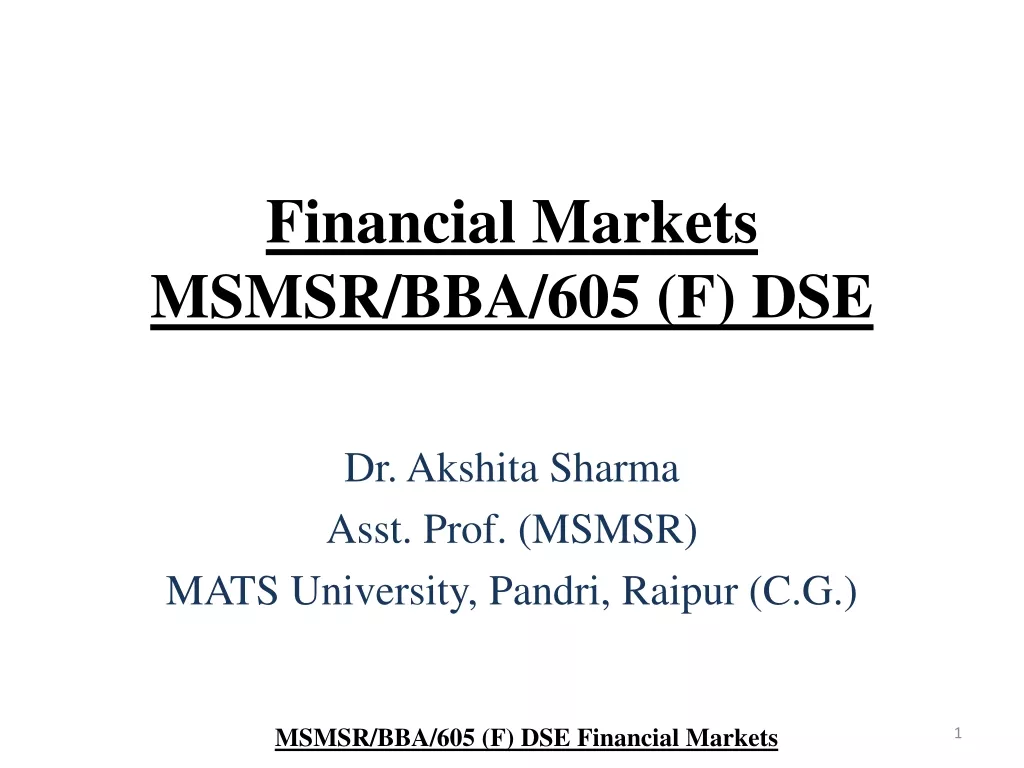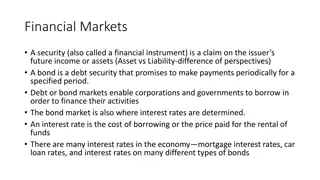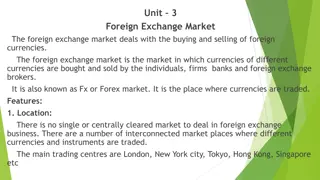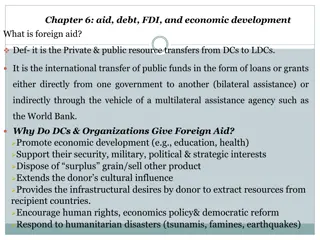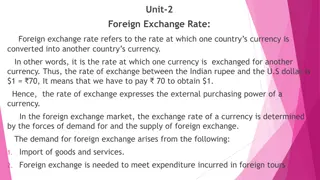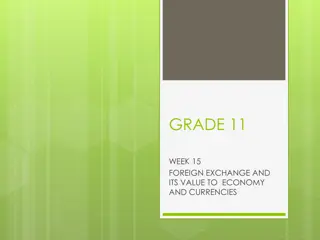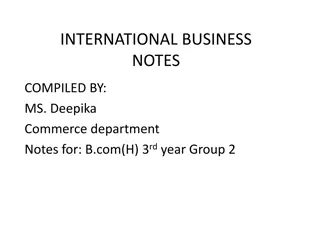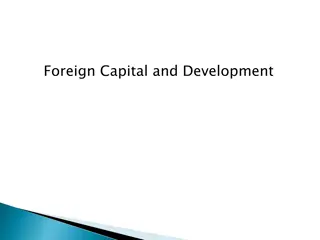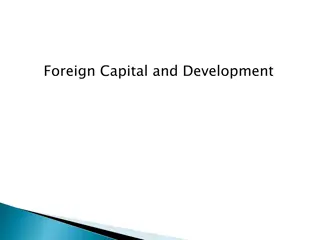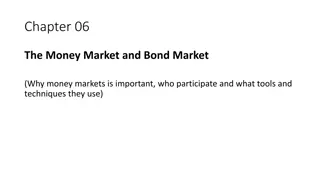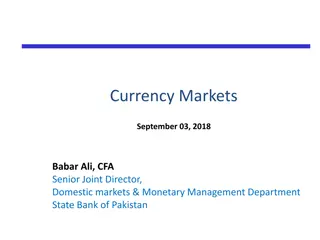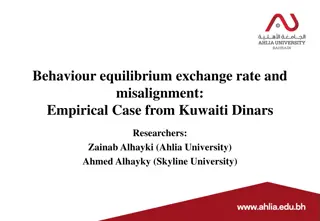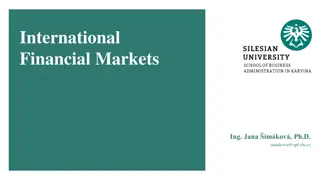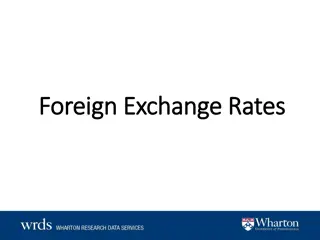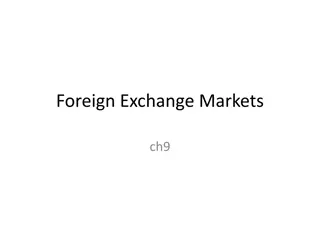Foreign Exchange Markets
The foreign exchange market is a crucial part of the global economy, determining exchange rates that impact trade and investment worldwide. This chapter delves into exchange rate dynamics, foreign exchange transactions, and the importance of currency valuations in international trade.
Download Presentation

Please find below an Image/Link to download the presentation.
The content on the website is provided AS IS for your information and personal use only. It may not be sold, licensed, or shared on other websites without obtaining consent from the author.If you encounter any issues during the download, it is possible that the publisher has removed the file from their server.
You are allowed to download the files provided on this website for personal or commercial use, subject to the condition that they are used lawfully. All files are the property of their respective owners.
The content on the website is provided AS IS for your information and personal use only. It may not be sold, licensed, or shared on other websites without obtaining consent from the author.
E N D
Presentation Transcript
Topic 10: Topic 10: The Foreign Exchange Market The Foreign Exchange Market Main Reading (Sources): Chap 15 Mishkin & Eakins, 8th
Chapter Preview In this chapter, we develop a modern view of exchange rate determination that explains recent behavior in the foreign exchange market. Topics include: Foreign Exchange Market Exchange Rates in the Long Run Exchange Rates in the Short Run Explaining Changes in Exchange Rates
Foreign Exchange Market (1 of 2) Most countries of the world have their own currencies: the U.S dollar., the euro in Europe, the Brazilian real, and the Chinese yuan, just to name a few. The trading of currencies and banks deposits is what makes up the foreign exchange market. Two kinds of exchange rate transactions make up the foreign exchange market: Spot transactions involve the near-immediate exchange of bank deposits, completed at the spot rate. Forward transactions involve exchanges at some future date, completed at the forward rate.
Figure 15.1 Exchange Rates, 19902016 Source: Federal Reserve Bank of St. Louis FRED database: https://fred.stlouisfed.org/series/EXCAUS; https://fred.stlouisfed.org/series/EXUSUK; https://fred.stlouisfed.org/series/EXJPUS; https://fred.stlouisfed.org/series/EXUSEU.
Why Are Exchange Rates Important? (1 of 2) When the currency of your country appreciates relative to another country, your country s goods prices abroad and foreign goods prices in your country. Makes domestic businesses less competitive Benefits domestic consumers (you)
Why Are Exchange Rates Important? (2 of 2) For example, in 1999, the euro was valued at $1.18. On June 16, 2016, it was valued at $1.1132. Euro depreciated 5.6% (1.1132 1.18) / 1.18 Dollar appreciated 6.0% (0.898 0.847) / 0.847 Note: 0.898 = 1 / 1.1132, and 0.847 = 1 / 1.18
Foreign Exchange Market: Exchange Rates FOLLOWING THE FINANCIAL NEWS Foreign Exchange Rates Foreign exchange rates are published daily in newspapers and Internet sites such as www.finance.yahoo.com. Exchange rates for a currency such as the euro are quoted in two ways: U.S. dollars per unit of domestic currency or domestic currency per U.S. dollar. For example, on June 16, 2016, the euro exchange rate was quoted as $1.1132 per euro and 0.8983 euro per dollar. Americans generally would regard the exchange rate with the euro as $1.11 per euro, while Europeans think of it as 0.90 euro per dollar. Exchange rates are quoted for the spot transaction (the spot exchange rate) and for forward transactions (the forward exchange rates) that will take place one month, three months, and six months in the future.
How is Foreign Exchange Traded? FX traded in over-the-counter market 1. Involve buying / selling bank deposits denominated in different currencies. 2. Trades involve transactions in excess of $1 million. 3. Typical consumers buy foreign currencies from retail dealers, such as American Express. FX volume exceeds $5 trillion per day.
Exchange Rates in the Long Run: Law of One Price (1 of 2) Exchange rates are determined in markets by the interaction of supply and demand. An important concept that drives the forces of supply and demand is the Law of One Price. The Law of One Price states that the price of an identical good will be the same throughout the world, regardless of which country produces it. Example: American steel costs $100 per ton, while Japanese steel costs 10,000 yen per ton.
Exchange Rates in the Long Run: Law of One Price (2 of 2) If E = 50 yen/$ then price are: Blank American Steel Blank Japanese Steel Blank In U.S. $100 $200 In Japan 5000 yen 10,000 yen Blank Blank Blank If E = 100 yen/$ then price are: Blank American Steel Blank Japanese Steel Blank In U.S. $100 $100 In Japan 10,000 yen 10,000 yen
Exchange Rates in the Long Run: Theory of Purchasing Power Parity (PPP) (1 of 2) The theory of PPP states that exchange rates between two currencies will adjust to reflect changes in price levels. PPP Domestic price level 10%, domestic currency 10% Application of law of one price to price levels Works in long run, not short run
Exchange Rates in the Long Run: Theory of Purchasing Power Parity (PPP) (2 of 2) Problems with PPP All goods are not identical in both countries (i.e., Toyota versus Chevy) Many goods and services are not traded (e.g., haircuts, land, etc.)
Figure 15.2 Purchasing Power Parity, United States/United Kingdom, 19732016 (Index: March 1973 = 100) Source: Federal Reserve Bank of St. Louis FRED database: https://fred.stlouisfed.org/series/CP0000GBM086NEST; https://fred.stlouisfed.org/series/CPIAUCNS; https://fred.stlouisfed.org/series/EXUSUK.
Exchange Rates in the Long Run: Factors Affecting Exchange Rates in Long Run (1 of 3) Basic Principle: If a factor increases demand for domestic goods relative to foreign goods, the exchange rate The four major factors are relative price levels, tariffs and quotas, preferences for domestic vs. foreign goods, and productivity.
Exchange Rates in the Long Run: Factors Affecting Exchange Rates in Long Run (2 of 3) Relative price levels: a rise in relative price levels cause a country s currency to depreciate. Tariffs and quotas: increasing trade barriers causes a country s currency to appreciate.
Exchange Rates in the Long Run: Factors Affecting Exchange Rates in Long Run (3 of 3) Preferences for domestic vs. foreign goods: increased demand for a country s good causes its currency to appreciate; increased demand for imports causes the domestic currency to depreciate. Productivity: if a country is more productive relative to another, its currency appreciates.
Table 15.1 Summary Factors That Affect Exchange Rates in the Long Run Factor Change in Factor Response of the Exchange Rate, E* (in terms of domestic currency) Domestic price level Increase Depreciation Trade barriers Increase Appreciation Import demand Increase Depreciation Export demand Increase Appreciation Productivity Increase Appreciation
Exchange Rates in the Short Run In the short run, an exchange rate is the price of domestic bank deposits in terms of foreign bank deposits. We will rely on the tools developed in Chapter 4 for the determinants of asset demand. The usual approach to supply-demand analysis focused on import/export demand Here, we emphasize stocks rather than flows, because flows are small relative to the domestic and foreign asset stocks.
Exchange Rates in the Short Run: Supply Curve Analysis We will use the US as the home country, so domestic assets are denominated in US dollars. We will use euros the generically represent any foreign country's currency. Dollar assets supplied is primarily the quantity of bank deposits, bonds, and equities in the United States. This is fairly fixed in the short-run. The quantity supplied at any exchange rate does not change, so the supply curve, S, is vertical.
Exchange Rates in the Short Run: Demand Curve Analysis The demand curve traces out the quantity demanded at each current exchange rate The current exchange rate and the expected future exchange rate are held constant in this analysis. Let s see a specific example that illustrates this point.
Deriving the Demand Curve Assume iF= 5%, Eet+1= 1 euro/$ Blank Point Blank A: Et= 1.05 (1.00 1.05)/1.05 = 4.8% B: Et= 1.00 (1.00 1.00)/1.00 = 0.0% C: Et+1= 0.95 (1.00 0.95)/0.95 = 5.2% The demand curve connects these points and is downward sloping because when Etis lower, expected appreciation of the dollar is higher.
Exchange Rates in the Short Run: Equilibrium Equilibrium Supply = Demand at E* If Et E*, Demand Supply, sell $, Et If Et E*, Demand Supply, buy $, Et
Explaining Changes in Exchange Rates To understand how exchange rates shift in time, we need to understand the factors that shift expected returns for domestic and foreign deposits. We will examine these separately, as well as changes in the money supply and exchange rate overshooting.
Figure 15.4 Response to an Increase in the Domestic Interest Rate, iD
Figure 15.5 Response to an Increase in the Foreign Interest Rate, iF
Figure 15.6 Response to an Increase in the Expected Future Exchange Rate, Eet+1
Explaining Changes in Exchanges Rates Similar to determinants of exchange rates in the long-run, the following changes increase the demand for foreign domestic goods (shifting the demand curve to the right), increasing ???+1 Expected fall in relative U.S. price levels Expected increase in relative U.S. trade barriers Expected lower U.S. import demand Expected higher foreign demand for U.S. exports Expected higher relative U.S. productivity
Table 15.2 Summary: Summary Factors That Shift the Demand Curve for Domestic Assets and Affect the Exchange Rate (1 of 2)
Table 15.2 Summary: Summary Factors That Shift the Demand Curve for Domestic Assets and Affect the Exchange Rate (2 of 2)
Applications (1 of 2) Our analysis allows us to take a look at the response of exchange rates to a variety of macro-economic factors. For example, we can use this framework to examine (1) the impact of changes in interest rates, and (2) the impact of money growth.
Application: Interest Rate Changes Changes in domestic interest rates are often cited in the press as affecting exchange rates. We must carefully examine the source of the change to make such a statement. Interest rates change because either (a) the real rate or (b) the expected inflation is changing. The effect of each differs.
Effect of Changes in Interest Rates on the Equilibrium Exchange Rate When the domestic real interest rate increases, the domestic currency appreciates. We have already seen this situation in Figure 15.4. When the domestic expected inflation increases, the domestic currency reacts in the opposite direction it depreciates. This is shown on the next slide.
Figure 15.7 Effect of a Rise in the Domestic Interest Rate as a Result of an Increase in Expected Inflation
Exchange rate volatility Exchange rate overshooting is important because it helps explain why foreign exchange rates are so volatile. Another explanation deals with changes in the expected appreciation of exchange rates. As anything changes our expectations (price levels, productivity, inflation, etc.), exchange rates will change immediately.
Applications (2 of 2) Our analysis also allows us to take a look at the weak dollar in the 1980s, and (partially) explain why it became stronger in the 1990s and 2000s. We present a summary in Figure 15.8, on the next slide.
The Dollar and Interest Rates A failure to distinguish between real and nominal interest rates can lead to poor predictions of exchange rate movements! Note the difference between real and nominal rates in the next figure. Which better explains the weakness of the dollar in the late 1970s and the strength of the dollar in the early 1980s?
Figure 15.8 Value of the Dollar and Interest Rates, 19732016 Source: Federal Reserve Bank of St. Louis FRED database: https://fred.stlouisfed.org/series/TWEXMMTH; https://fred.stlouisfed.org/series/TB3MS; real interest rate from Figure 3.1 in Chapter 3.
Case: The Global Financial Crisis and the Dollar Is there a relationship between the subprime crisis and swings in the value of the dollar? In August 2007, the dollar began an accelerated decline in value, falling by 9% against the euro through July 2008 The dollar suddenly shot upward, by over 20% against the euro by the end of October 2008. In 2007, the Fed lowered the fed funds rate by 325 bps, while ECBs did not need to do this. Relative return on the dollar fell, shifting demand to the left. By mid-2008, ECBs starting cutting their domestic rates, increasing the relative expected return of the US dollar (a rightward shift). A flight to quality in T- bonds also increased the demand for dollars.
The Practicing Manger: Profiting from FX Forecasts Forecasters look at factors discussed here FX forecasts affect financial institutions managers' decisions If forecast yen euro appreciate, yen depreciate, Sell franc assets, buy euro assets Make more euros loans, less yen loans FX traders sell yen, buy euros
Chapter Summary Foreign Exchange Market: the market for deposits in one currency versus deposits in another. Exchange Rates in the Long Run: driven primarily by the law of one price as it affects the four factors discussed. Exchange Rates in the Short Run: short-run rates are determined by the demand for assets denominated in both domestic and foreign currencies. Explaining Changes in Exchange Rates: factors leading to shifts in the demand and supply schedules were explored.


